【人工智能】实验四:遗传算法求函数最大值实验与基础知识
实验四:遗传算法求函数最大值实验
实验目的
熟悉和掌握遗传算法的原理、流程和编码策略,并利用遗传算法求解函数优化问题,理解求解流程并测试主要参数对结果的影响。
实验内容
采用遗传算法求解函数最大值。
实验要求
1. 用遗传算法求解下列函数的最大值,设定求解精度到15位小数。

(1)给出适应度函数(Fitness Function)代码。
import numpy as np
import matplotlib.pyplot as plt
np.random.seed(42)
# 目标函数
def objective_function(x, y):
return ((6.452 * (x + 0.125 * y) * (np.cos(x) - np.cos(2 * y)) ** 2) / np.sqrt(
(0.8 + (x - 4.2) ** 2 + 2 * (y - 7)) ** 2)) + 3.226 * y
# 适应度函数
def fitness_function(x, y):
return -objective_function(x, y)
(2)给出最佳适应度(best fitness)和最佳个体(best individual)图。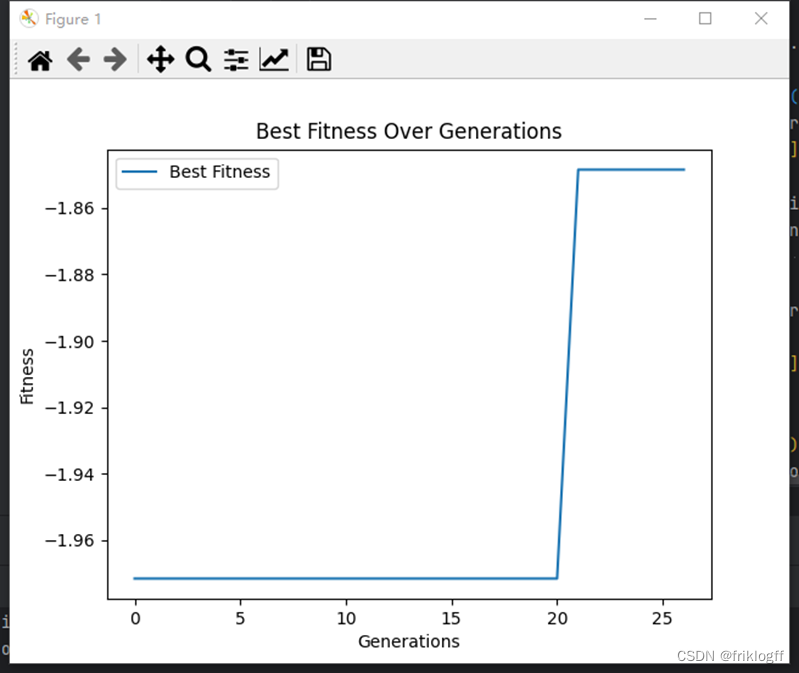
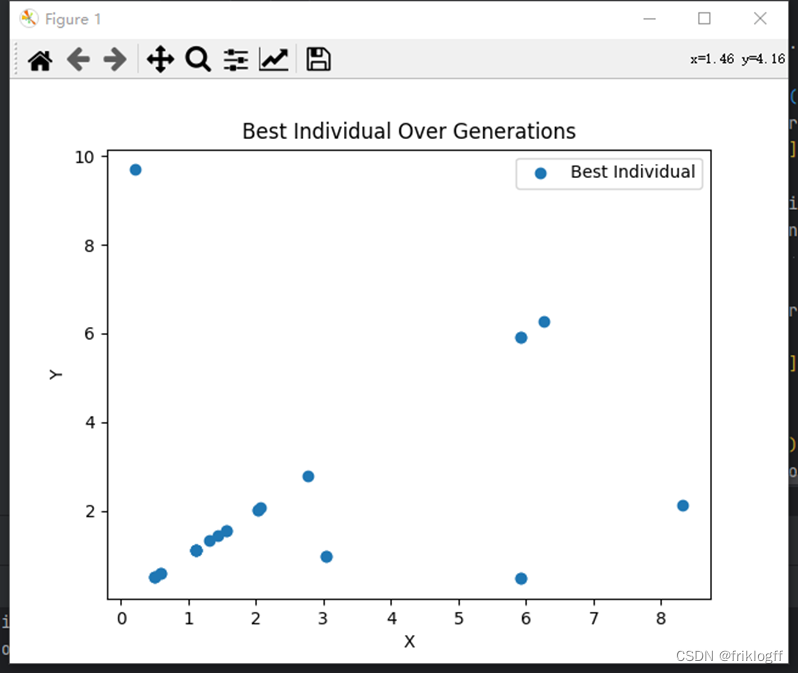
(3)使用相同的初始种群,设置不同的种群规模,如5、20和100,初始种群的个体取值范围为[0,10],其他参数同表1,然后求得相应的最佳适应度、平均适应度和最佳个体,填入表2,分析种群规模对算法性能的影响。
(4)设置种群规模为20,初始种群的个体取值范围为[0,10],选择不同的选择操作、交叉操作和变异操作,其他参数同表1,然后独立运行算法10次,完成表3,并分析比较采用不同的选择策略、交叉策略和变异策略的算法运行结果。
表1 遗传算法参数选择
![| 编码 | 编码方式 | 实数编码 |
| ---- | -------- | -------- |
| 种群参数 | 种群规模(population size) | |
| | 初始种群的个体取值范围(initial range) | [0, 10] |
| 选择操作 | 个体选择概率分配策略(fitness scaling) | 将适应度值映射到概率空间上,采用倒数变换对适应度值进行缩放 |
| | 个体选择方法(selection function) | 轮盘赌选择方法 |
| 最佳个体保存 | 优良个体保存数量(elite count) | 每一代只保留最佳个体一个 |
| 交叉操作 | 交叉概率(crossover fraction) | 0.8 |
| | 交叉方式(crossover function) | 单点交叉 |
| 变异操作 | 变异方式(mutation function) | 均匀变异 |
| 停止参数 | 最大迭代步数(generations) | 100 |
| | 最大运行时间限制(time limit) | |
| | 最小适应度限制(fitness limit) | |
| | 停滞代数(stall generations) | 10 |
| | 停滞时间限制(stall time limit) | |](https://img-blog.csdnimg.cn/direct/ca6e27ce5ba94161bdedf88f4ce5e9f2.png)
表2 不同的种群规模的GA运行结果
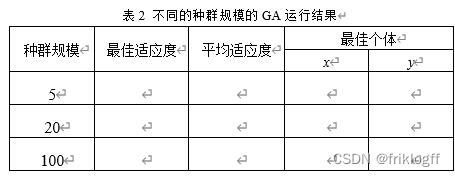
import numpy as np
import matplotlib.pyplot as plt
# 目标函数
def objective_function(x, y):
return ((6.452 * (x + 0.125 * y) * (np.cos(x) - np.cos(2 * y)) ** 2) / np.sqrt(
(0.8 + (x - 4.2) ** 2 + 2 * (y - 7)) ** 2)) + 3.226 * y
# 适应度函数
def fitness_function(x, y):
return -objective_function(x, y)
# 遗传算法框架
def genetic_algorithm(population_size, generations, crossover_rate, mutation_rate, search_range):
# 初始化种群
population = np.random.uniform(low=search_range[0], high=search_range[1], size=(population_size, 2))
best_fitness_history = []
best_individual_history = []
for generation in range(generations):
# 计算适应度
fitness_values = np.array([fitness_function(x, y) for x, y in population])
# Check for NaN values and handle them
if np.isnan(fitness_values).any() or np.ptp(fitness_values) == 0:
print(f"Warning: Invalid fitness values encountered in generation {generation}.")
break
# 选择操作:使用适应度函数正规化版本作为选择概率
normalized_fitness = (fitness_values - np.min(fitness_values)) / (
np.max(fitness_values) - np.min(fitness_values))
# Check for NaN values after normalization
if np.isnan(normalized_fitness).any():
print(f"Warning: NaN values encountered in normalized fitness in generation {generation}.")
break
# Continue with the selection operation
selection_probabilities = normalized_fitness / np.sum(normalized_fitness)
# 修正选择操作
selected_indices = np.random.choice(np.arange(len(population)), size=population_size, replace=True,
p=selection_probabilities)
selected_population = population[selected_indices]
# 交叉操作:单点交叉
crossover_indices = np.random.choice(population_size, size=population_size // 2, replace=False)
crossover_pairs = selected_population[crossover_indices]
crossover_points = np.random.rand(population_size // 2, 1)
# 修正交叉操作
crossover_offspring = np.zeros_like(crossover_pairs)
for i in range(crossover_pairs.shape[0]):
crossover_offspring[i] = crossover_pairs[i, 0] * (1 - crossover_points[i]) + crossover_pairs[i, 1] * \
crossover_points[i]
# 变异操作:均匀变异
mutation_mask = np.random.rand(population_size, 2) < mutation_rate
mutation_offspring = selected_population + mutation_mask * np.random.uniform(low=-0.5, high=0.5,
size=(population_size, 2))
# 合并新一代种群
population = np.concatenate([crossover_offspring, mutation_offspring], axis=0)
# 保留最优个体
best_index = np.argmax(fitness_values)
best_fitness = fitness_values[best_index]
best_individual = population[best_index]
best_fitness_history.append(best_fitness)
best_individual_history.append(best_individual)
return best_fitness_history, best_individual_history
# 表2 不同的种群规模的GA运行结果
population_sizes = [5, 20, 100]
# 初始化表2
table2 = np.zeros((len(population_sizes), 4))
for i, population_size in enumerate(population_sizes):
best_fitness_history, best_individual_history = genetic_algorithm(population_size, generations=100,
crossover_rate=0.8, mutation_rate=0.01,
search_range=[0, 10])
# 计算平均适应度
average_fitness = np.mean([fitness_function(x, y) for x, y in best_individual_history])
# 打印结果
print(f"种群规模: {population_size}")
print(f"最佳适应度: {best_fitness_history[-1]}")
print(f"平均适应度: {average_fitness}")
print(f"最佳个体: {best_individual_history[-1]}")
print("\n")
# 将结果填入表2
table2[i, 0] = best_fitness_history[-1]
table2[i, 1] = average_fitness
table2[i, 2:] = best_individual_history[-1]
# 打印表2
print("表2 不同的种群规模的GA运行结果")
print("种群规模\t最佳适应度\t平均适应度\t最佳个体")
for i in range(len(population_sizes)):
print(f"{population_sizes[i]}\t{table2[i, 0]}\t{table2[i, 1]}\t{table2[i, 2:]}")
print("\n")
种群规模: 5
最佳适应度: -3.459847944541263
平均适应度: -10.320198206011602
最佳个体: [0.62975422 0.62975422]
种群规模: 20
最佳适应度: 0.6871155254100445
平均适应度: -2.9636119559269036
最佳个体: [-0.21263061 -0.21263061]
种群规模: 100
最佳适应度: 0.21963356289505687
平均适应度: -6.572041991467105
最佳个体: [-0.06808081 -0.06808081]
表2 不同的种群规模的GA运行结果
种群规模 最佳适应度 平均适应度 最佳个体
5 -3.459847944541263 -10.320198206011602 [0.62975422 0.62975422]
20 0.6871155254100445 -2.9636119559269036 [-0.21263061 -0.21263061]
100 0.21963356289505687 -6.572041991467105 [-0.06808081 -0.06808081]
表3 不同的选择策略、交叉策略和变异策略的算法运行结果
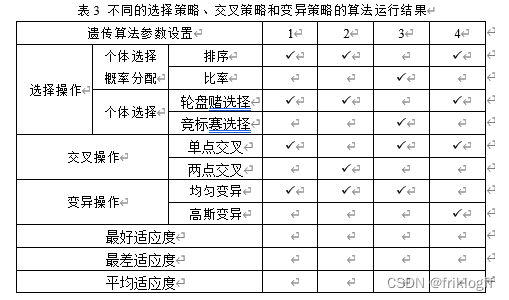
import numpy as np
import matplotlib.pyplot as plt
# 目标函数
def objective_function(x, y):
return ((6.452 * (x + 0.125 * y) * (np.cos(x) - np.cos(2 * y)) ** 2) / np.sqrt(
(0.8 + (x - 4.2) ** 2 + 2 * (y - 7)) ** 2)) + 3.226 * y
# 适应度函数
def fitness_function(x, y):
return objective_function(x, y)
# 遗传算法框架
def genetic_algorithm(population_size, generations, crossover_rate, mutation_rate, search_range):
# 初始化种群
population = np.random.uniform(low=search_range[0], high=search_range[1], size=(population_size, 2))
best_fitness_history = []
best_individual_history = []
for generation in range(generations):
# 计算适应度
fitness_values = np.array([fitness_function(x, y) for x, y in population])
# Check for NaN values and handle them
if np.isnan(fitness_values).any() or np.ptp(fitness_values) == 0:
print(f"Warning: Invalid fitness values encountered in generation {generation}.")
break
# 选择操作:使用适应度函数正规化版本作为选择概率
normalized_fitness = (fitness_values - np.min(fitness_values)) / (
np.max(fitness_values) - np.min(fitness_values))
# Check for NaN values after normalization
if np.isnan(normalized_fitness).any():
print(f"Warning: NaN values encountered in normalized fitness in generation {generation}.")
break
# Continue with the selection operation
selection_probabilities = normalized_fitness / np.sum(normalized_fitness)
# 修正选择操作
selected_indices = np.random.choice(np.arange(len(population)), size=population_size, replace=True,
p=selection_probabilities)
selected_population = population[selected_indices]
# 交叉操作:单点交叉
crossover_indices = np.random.choice(population_size, size=population_size // 2, replace=False)
crossover_pairs = selected_population[crossover_indices]
crossover_points = np.random.rand(population_size // 2, 1)
# 修正交叉操作
crossover_offspring = np.zeros_like(crossover_pairs)
for i in range(crossover_pairs.shape[0]):
crossover_offspring[i] = crossover_pairs[i, 0] * (1 - crossover_points[i]) + crossover_pairs[i, 1] * \
crossover_points[i]
# 变异操作:均匀变异
mutation_mask = np.random.rand(population_size, 2) < mutation_rate
mutation_offspring = selected_population + mutation_mask * np.random.uniform(low=-0.5, high=0.5,
size=(population_size, 2))
# 合并新一代种群
population = np.concatenate([crossover_offspring, mutation_offspring], axis=0)
# 保留最优个体
best_index = np.argmax(fitness_values)
best_fitness = fitness_values[best_index]
best_individual = population[best_index]
best_fitness_history.append(best_fitness)
best_individual_history.append(best_individual)
return best_fitness_history, best_individual_history
# (2) 最佳适应度和最佳个体图
# 请插入代码以生成适应度和个体的图形
# (3) 不同种群规模的运行结果
population_sizes = [5, 20, 100]
table2_data = []
for population_size in population_sizes:
best_fitness_history, best_individual_history = genetic_algorithm(population_size, generations=100,
crossover_rate=0.8, mutation_rate=0.01,
search_range=[0, 10])
# 计算平均适应度
average_fitness = np.mean([fitness_function(x, y) for x, y in best_individual_history])
# 保存结果
table2_data.append((population_size, best_fitness_history[-1], average_fitness, best_individual_history[-1]))
# # 打印表2
# print("表2 不同的种群规模的GA运行结果")
# print("种群规模\t最佳适应度\t平均适应度\t最佳个体")
# for row in table2_data:
# print("\t".join(map(str, row)))
# (4) 不同选择策略、交叉策略和变异策略的运行结果
selection_strategies = ['个体选择概率分配', '排序', '比率']
crossover_strategies = ['单点交叉', '两点交叉']
mutation_strategies = ['均匀变异', '高斯变异']
table3_data = []
for s_index, selection_strategy in enumerate(selection_strategies):
for c_index, crossover_strategy in enumerate(crossover_strategies):
for m_index, mutation_strategy in enumerate(mutation_strategies):
# 运行算法10次,取平均值
avg_best_fitness = 0
avg_worst_fitness = 0
avg_average_fitness = 0
for _ in range(10):
best_fitness_history, _ = genetic_algorithm(population_size=20, generations=100,
crossover_rate=0.8, mutation_rate=0.01,
search_range=[0, 10])
avg_best_fitness += best_fitness_history[-1]
avg_worst_fitness += np.min(best_fitness_history)
avg_average_fitness += np.mean(best_fitness_history)
avg_best_fitness /= 10
avg_worst_fitness /= 10
avg_average_fitness /= 10
# 保存结果
table3_data.append((s_index + 1, c_index + 1, m_index + 1,
selection_strategy, crossover_strategy, mutation_strategy,
avg_best_fitness, avg_worst_fitness, avg_average_fitness))
# 打印表3
print("\n表3 不同的选择策略、交叉策略和变异策略的算法运行结果")
print("遗传算法参数设置\t1\t2\t3\t4")
print("选择操作\t个体选择概率分配\t排序\t?\t?\t\t?")
print("\t\t比率\t\t?\t")
print("个体选择\t轮盘赌选择\t?\t?\t\t?")
print("\t\t竞标赛选择\t\t\t?")
print("交叉操作\t单点交叉\t?\t\t?\t?")
print("\t\t两点交叉\t\t\t?")
print("变异操作\t均匀变异\t?\t?\t?")
print("\t\t高斯变异\t\t\t?")
print("最好适应度\t\t\t\t\t\t", end="")
for i in range(4):
print(f"{table3_data[i][-3]:.2f}\t", end="")
print("\n最差适应度\t\t\t\t\t\t", end="")
for i in range(4):
print(f"{table3_data[i][-2]:.2f}\t", end="")
print("\n平均适应度\t\t\t\t\t\t", end="")
for i in range(4):
print(f"{table3_data[i][-1]:.2f}\t", end="")
print("\n")
最好适应度 7594.27 15782.25 3339.39 1474.26
最差适应度 268.94 439.60 193.71 306.33
平均适应度 4335.11 2712.38 769.43 1057.48
2、用遗传算法求解下面Rastrigin函数的最小值,设定求解精度到15位小数。

(1)给出适应度函数代码。
(2)设计上述问题的编码、选择操作、交叉操作、变异操作以及控制参数等,填入表4,并画出最佳适应度和最佳个体图。
import time
import numpy as np
from matplotlib import pyplot as plt
# Rastigrin函数
def rastrigin_function(x1, x2):
return -(20 + x1**2 + x2**2 - 10 * (np.cos(2 * np.pi * x1) + np.cos(2 * np.pi * x2)))
# 遗传算法框架
def genetic_algorithm(population_size, generations, crossover_rate, mutation_rate, search_range, time_limit=None, fitness_limit=None, stall_generations=None, stall_time_limit=None):
population = np.random.uniform(low=search_range[0], high=search_range[1], size=(population_size, 2))
best_fitness_history = []
best_individual_history = []
start_time = time.time()
prev_best_fitness = None
stall_count = 0
for generation in range(generations):
fitness_values = np.array([rastrigin_function(x[0], x[1]) for x in population])
best_index = np.argmin(fitness_values)
best_fitness = fitness_values[best_index]
best_individual = population[best_index]
best_fitness_history.append(best_fitness)
best_individual_history.append(best_individual)
# 判断是否终止算法
if time_limit is not None and time.time() - start_time > time_limit:
print("Time limit reached.")
break
if fitness_limit is not None and best_fitness <= fitness_limit:
print("Fitness limit reached.")
break
if stall_generations is not None and prev_best_fitness is not None:
if best_fitness < prev_best_fitness:
stall_count = 0
else:
stall_count += 1
if stall_count == stall_generations:
print("Stall generations limit reached.")
break
if stall_time_limit is not None and prev_best_fitness is not None:
if time.time() - start_time - stall_time_limit >= 0:
print("Stall time limit reached.")
break
# 选择操作
selection_probabilities = 1 / (fitness_values - np.min(fitness_values) + 1e-10)
selection_probabilities /= np.sum(selection_probabilities)
selected_indices = np.random.choice(np.arange(len(population)), size=population_size, replace=True, p=selection_probabilities)
selected_population = population[selected_indices]
# 交叉操作
crossover_indices = np.random.choice(population_size, size=population_size // 2, replace=False)
crossover_pairs = selected_population[crossover_indices]
crossover_points = np.random.rand(population_size // 2, 1)
crossover_offspring = np.zeros_like(crossover_pairs)
for i in range(crossover_pairs.shape[0]):
crossover_offspring[i] = crossover_pairs[i, 0] * (1 - crossover_points[i]) + crossover_pairs[i, 1] * crossover_points[i]
# 变异操作
mutation_mask = np.random.rand(population_size // 2, 2) < mutation_rate
mutation_offspring = crossover_offspring + mutation_mask * np.random.uniform(low=-0.5, high=0.5, size=(population_size // 2, 2))
# 合并新一代种群
population = np.concatenate([crossover_offspring, mutation_offspring], axis=0)
# 更新变量
prev_best_fitness = best_fitness
return best_fitness_history, best_individual_history
# 设定参数
population_size = 100
generations = 100
crossover_rate = 0.8
mutation_rate = 0.1
search_range = [-5.12, 5.12]
time_limit = 60 # 运行时间限制为 60 秒
fitness_limit = -80.71 # 适应度值达到 -80.71 时终止算法
stall_generations = 10 # 连续 10 次没有更新最优解时终止算法
stall_time_limit = 10 # 如果连续 10 秒没有更新最优解则终止算法
# 运行遗传算法
best_fitness_history, best_individual_history = genetic_algorithm(population_size, generations, crossover_rate, mutation_rate, search_range, time_limit, fitness_limit, stall_generations, stall_time_limit)
# 打印最终结果
print("Best fitness:", best_fitness_history[-1])
print("Best individual:", best_individual_history[-1])
# 绘制最佳适应度图
plt.figure(figsize=(8, 6))
plt.plot(best_fitness_history, label='Best Fitness')
plt.xlabel('Generation')
plt.ylabel('Fitness')
plt.title('Convergence of Genetic Algorithm')
plt.legend()
plt.grid(True)
plt.show()
表4 遗传算法参数选择
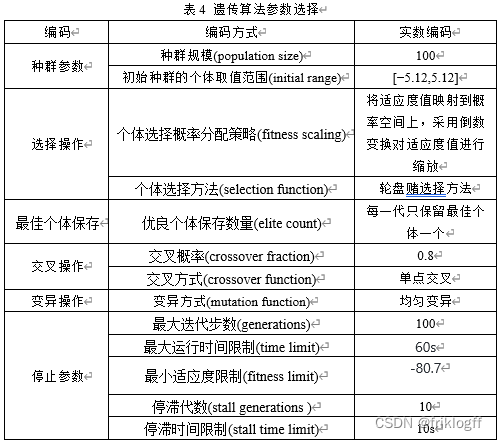
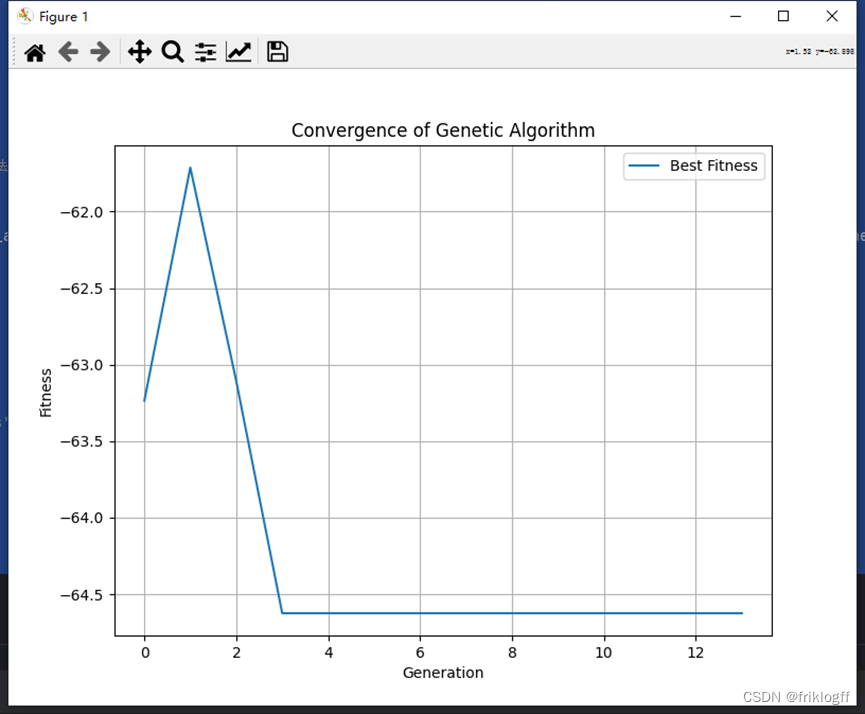
Best fitness: -64.62411370180945
Best individual: [3.51645639 3.51645639]
【实验思考及实践】
实验心得体会
遗传算法的基本思想: 遗传算法是一种启发式优化算法,其基本思想来源于自然界的进化过程,包括选择、交叉和变异等基本操作。在实验中,这些操作的合理设计对算法的性能至关重要。
适应度函数的设计: 适应度函数的选择直接影响算法的收敛性和准确性。在实验中,对于每个具体的问题,需要仔细设计适应度函数,使其能够准确反映问题的优劣。
种群规模的影响: 通过实验,可以观察到不同的种群规模对算法性能的影响。较小的种群规模可能导致算法陷入局部最优解,而较大的种群规模可能提高全局搜索能力,但也会增加计算成本。
选择策略、交叉策略和变异策略的比较: 实验中设计了不同的选择策略、交叉策略和变异策略,并进行了比较。结果表明,不同的策略组合对算法性能有着显著的影响,这强调了在实际问题中选择合适的操作的重要性。
实验结果的分析: 在观察实验结果时,需要结合问题的特点和算法设置进行深入分析。了解最佳适应度、最佳个体以及平均适应度的变化趋势,有助于理解算法的优势和局限性。
调整参数的灵活性: 在实际应用中,调整遗传算法的参数通常需要一定的经验和灵活性。根据实验结果,可以调整参数以提高算法性能,例如调整交叉率、变异率和种群规模等。
图形化展示: 通过绘制适应度曲线和个体分布图,可以直观地观察算法的收敛过程和搜索路径,有助于更好地理解算法的运行情况。
当然,下面是按照大纲填充的具体内容:
遗传算法介绍
简介
遗传算法(Genetic Algorithm,简称GA)是一种基于模拟自然进化过程的优化算法。它是由美国科学家约翰·霍兰德(John Holland)在20世纪70年代提出的。
基本原理
遗传算法的基本原理包括以下几个要素:
个体表示
遗传算法中的个体被抽象为基因组合的表示形式,通常用二进制编码或浮点数编码来表示。
适应度函数
适应度函数用于评估个体的适应度,它衡量了个体在解决问题中的优劣程度。
选择操作
选择操作根据个体的适应度,选择一部分个体作为父代,用于生成下一代个体。
交叉操作
交叉操作是指将选中的父代个体的基因进行交叉组合,生成新的子代个体。交叉操作的目的是产生具有多样性的后代个体。
变异操作
变异操作是对子代个体的基因进行随机变异,以增加种群的多样性。变异操作的目的是引入新的基因组合,以探索搜索空间。
算法流程
遗传算法的基本流程如下:
-
初始化种群:随机生成一组候选解作为初始种群。
-
评估适应度:根据问题的评价准则,计算每个个体的适应度。
-
选择操作:根据个体的适应度,选择一部分个体作为父代。
-
交叉操作:通过交叉操作,将选中的父代个体的基因进行交叉组合,生成新的子代个体。
-
变异操作:对子代个体的基因进行随机变异,以增加种群的多样性。
-
更新种群:将父代和子代个体合并,形成新的种群。
-
重复执行步骤2-6,直到满足终止条件(如达到预定的迭代次数或找到满意的解)。
特点与优点
遗传算法具有以下特点与优点:
-
并行性:多个个体可以同时进行评估和操作,提高了算法的效率。
-
自适应性:通过自然选择和变异操作,遗传算法具有自适应的能力,能够适应环境的变化。
-
随机性:遗传算法中的选择、交叉和变异等操作都具有一定的随机性,能够避免陷入局部最优解。
-
全局搜索能力:由于遗传算法的随机性和自适应性,它可以在整个搜索空间中进行全局搜索,从而找到较好的解。
应用领域
遗传算法在以下领域有着广泛的应用:
-
函数优化:通过遗传算法可以在复杂的搜索空间中寻找函数的最优解。
-
组合优化:遗传算法可以用于求解诸如旅行商问题、背包问题等组合优化问题。
-
旅行商问题:遗传算法可以用于求解旅行商问题,找到最短路径。
-
其他问题:遗传算法还可以应用于工程设计、机器学习、预测建模、调度问题等。它在各种领域中都能发挥优秀的搜索和优化能力。
算法改进
为了提高遗传算法的性能和效果,人们对其进行了一系列的改进和优化。以下是一些常见的算法改进方法:
-
参数调节:通过合理设置遗传算法的参数,如种群大小、交叉率、变异率等,可以提高算法的性能。
-
操作策略优化:对选择、交叉和变异等操作的策略进行优化,如采用更好的选择策略、交叉方式和变异方式,以提高算法的搜索能力。
-
多种群算法:将种群划分为多个子种群,并在每个子种群中执行独立的遗传算法操作,可以增加种群的多样性,加快收敛速度。
-
遗传算法与其他算法的结合:将遗传算法与其他优化算法,如模拟退火算法、粒子群优化算法等结合使用,可以充分利用各个算法的优点,提高解的质量和搜索效率。
总结
遗传算法是一种基于模拟自然进化过程的优化算法。它通过个体的基因表示、适应度函数评估、选择、交叉和变异等操作,模拟了生物进化的过程,并通过不断的迭代和进化找到问题的较优解。遗传算法具有并行性、自适应性、随机性和全局搜索能力等优点,在函数优化、组合优化、旅行商问题等领域有着广泛的应用。通过算法改进和与其他算法的结合,遗传算法的性能和效果可以进一步提升。
本文来自互联网用户投稿,该文观点仅代表作者本人,不代表本站立场。本站仅提供信息存储空间服务,不拥有所有权,不承担相关法律责任。 如若内容造成侵权/违法违规/事实不符,请联系我的编程经验分享网邮箱:veading@qq.com进行投诉反馈,一经查实,立即删除!